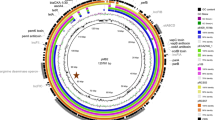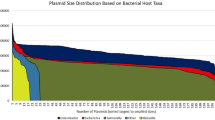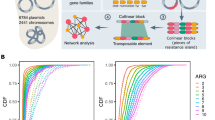Abstract
Conjugative plasmids were common in enterobacteria isolated before the medical use of antibiotics. Plasmid F of Escherichia coli K-12 was one example and we1 identified others in over 20% of a collection of strains isolated between 1917 and 1954, the Murray collection. In the past 25 years, conjugative plasmids encoding antibiotic resistances have become common in bacteria of the same genera as those of the Murray Collection—Salmonella, Shigella, Klebsiella, Proteus, Escherichia. The present study was made to show whether the ‘pre-antibiotic’ plasmids belonged to the same groups, as defined by incompatibility tests (Inc groups), as modern R plasmids. Of 84 such plasmids established in E. coli K-12, none with antibiotic resistance determinants, 65 belonged to the same groups as present resistance (R) plasmids. Thus the remarkable way in which medically important bacteria have acquired antibiotic resistance in the past 25 years seems to have been by the insertion of new genes into existing plasmids rather than by the spread of previously rare plasmids.
This is a preview of subscription content, access via your institution
Access options
Subscribe to this journal
Receive 51 print issues and online access
$199.00 per year
only $3.90 per issue
Buy this article
- Purchase on Springer Link
- Instant access to full article PDF
Prices may be subject to local taxes which are calculated during checkout
Similar content being viewed by others
References
Hughes, V. M. & Datta, N. Nature 302, 725–726 (1983).
Campbell, A. et al. in DNA Insertion Elements, Plasmids and Episomes (eds Bukhari, A. I., Shapiro, J. A. & Adhya, S. L.) 15–22 (Cold Spring Harbor Laboratory, New York, 1977).
Datta, N. et al. J. gen. Microbiol. 118, 495–508 (1980).
Frost, J. A., Rowe, B., Vandepitte, J. & Threlfall, E. J. Lancet ii, 1074–1076 (1981).
Threlfall, E. J., Frost, J. A., King, H. C. & Rowe, B. J. Hyg., Camb. 90, 55–60 (1983).
Frost, J. A. & Rowe, B. J. Hyg., Camb. 90, 27–32 (1983).
Bradley, D. E. & Rutherford, E. L. Can. J. Microbiol. 21, 152–163 (1975).
Davis, J. E., Strauss, J. H. & Sinsheimer, R. L. Science 134, 1427 (1961).
Khatoon, H., Iyer, R. V. & Iyer, V. N. Virology 48, 145–155 (1972).
Rowe, B., Frost, J. A., Threlfall, E. J. & Ward, L. R. Lancet i, 1070–1071 (1980).
Nevers, P. & Saedler, H. Nature 268, 109–115 (1977).
Jacob, A. E. et al. in DNA Insertion Elements, Plasmids and Episomes (eds Bukhari, A. I., Shapiro, J. A. & Adhya, S. L.) 607–638 (Cold Spring Harbor Laboratory, New York, 1977).
Bradley, D. E., Hughes, V. M., Richards, H. & Datta, N. Plasmid 7, 230–238 (1982).
Tschäpe, H., Tietze, E. & Koch, C. J. gen. Microbiol. 127, 155–160 (1981).
Bradley, D. E. Plasmid 4, 155–169 (1980).
Hedges, R. W. J. gen. Microbiol. 81, 171–181 (1974).
Author information
Authors and Affiliations
Rights and permissions
About this article
Cite this article
Datta, N., Hughes, V. Plasmids of the same Inc groups in Enterobacteria before and after the medical use of antibiotics. Nature 306, 616–617 (1983). https://doi.org/10.1038/306616a0
Received:
Accepted:
Issue Date:
DOI: https://doi.org/10.1038/306616a0
This article is cited by
-
Antimicrobial Resistance in Bacteria: Mechanisms, Evolution, and Persistence
Journal of Molecular Evolution (2020)
-
Genetic Analysis of the IncX4 Plasmids: Implications for a Unique Pattern in the mcr-1 Acquisition
Scientific Reports (2017)
-
Compensatory mutations improve general permissiveness to antibiotic resistance plasmids
Nature Ecology & Evolution (2017)
Comments
By submitting a comment you agree to abide by our Terms and Community Guidelines. If you find something abusive or that does not comply with our terms or guidelines please flag it as inappropriate.



